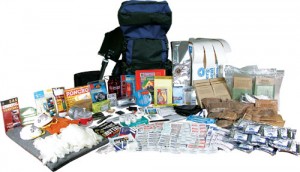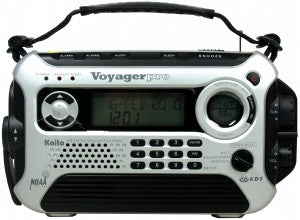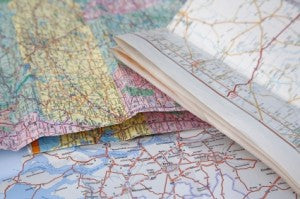Living in, commuting into, and working in the city presents its own set of challenges when it comes to emergency preparedness—so we’ve compiled a list of tips that are especially relevant to those thinking about urban emergency preparedness.
Events like 9/11 and Hurricane Sandy have shown that New Yorkers are an incredibly resilient bunch, and we want to help increase that resilience. So, here are Emergency Essentials’ top preparedness tips:
Tip: Do what you can in the space you have.
If you live in the city, space is likely in short supply, and you may not think you’ve got room for emergency water, food, and gear. But believe me, if the time comes to use them, you’ll be glad you made room in the closet, sacrificed a couple pairs of shoes to make room on your shoe shelf, or consolidated bins to fit a few things under the bed.
It doesn't take a lot of space (or even much money) to get the supplies to meet your basic needs for a few days up to two weeks. (Three days is the
minimum recommended length to prepare for, though, realistically, it can take much longer for help to become available and utilities to be restored in a large-scale disaster). Set aside part of the linen closet, a kitchen cupboard, or another space for your emergency supplies.
Tip: Build or buy a good, comprehensive emergency kit that will provide at least three days’ worth of the following:
- Water
- Food
- Shelter (a basic tent, or even a basic poncho can cut it—or go for something a little more substantial)
- Warmth (an emergency blanket and some long-lasting hand and body warmers are great for this and take very little space).
- Light (a headlamp is great for light while keeping your hands free for getting things done)
- Communications (at minimum a whistle to help rescuers Replace you if needed)
- First Aid
- Sanitation (toothbrush, toothpaste, shampoo, hand sanitizer, wipes, toilet paper, feminine products)
- Comfort items (something to distract you while you wait in potentially long lines or spend time stuck inside): books, games, a deck or two of cards, pencil/pen and notebook, etc.
- Custom items for you: an extra pair of glasses, contacts and solution, medications, etc.
- Copies of your important documents in case you have to evacuate at a moments’ notice
 Tip: Think about Power and Communication
Tip: Think about Power and Communication
After Hurricane Sandy, electricity and internet connections were hot commodities. While we can’t guarantee you a good source for providing your own internet connection, we can recommend a couple of great items to keep your phone and other electronics (and even your fridge) powered up:
- Get some solar power in your corner. For just a couple hundred dollars you can get a good solar panel and a power pack to store the power the panel(s) collects from the sun.
- Keep your power pack plugged into the wall until you need it for an emergency—then it will be ready to go right away.
- Solar power will only help if the sun comes out—so keep your devices running only when you need them.
- Get items that can use a variety of power sources, like radios or flashlights that have a hand-crank option. Sometimes in an emergency you won’t have electricity, but you’ll have all the time in the world to hand-crank a device to power it up (and many of them only take a minute or so of cranking to get powered up).
Tip: Consider an “Everyday Carry”
Many people carry small items with them every day to help in case of an emergency. I personally carry a pair of collapsible flats in my purse, since I’m a stilettos girl, and I also carry my phone’s USB cord so I can plug it into the Goal Zero® Switch 8 to recharge it if my battery gets too low.
Some other items I carry with me every day:
adhesive bandages, over-the-counter medicines like
pain relievers and allergy pills, tweezers, a small
knife, a bottle of water, and a small, high-calorie snack (like a
Millenium calorie bar) to give me energy if I’m stranded without food for several hours. That’s in addition to the things you might normally Replace in a woman’s purse, like fingernail clippers, sunglasses, etc. Think about the crucial things you would want in an emergency if you’re away from your home, office, or car emergency kit—what would you need in order to survive until you can get to a safe location that has supplies available?
If you don’t carry a purse, messenger bag, man-bag, or briefcase, consider changing things up and carrying a small bag with you so you can keep some essentials—especially water and food—with you. Also think about getting a small survival kit like the Bear Grylls Ultimate Survival Kit by Gerber or the Origin™ Survival Kit by SOL—they fit a lot of utility in a small space. Some people even build their own tiny survival kit into something like an empty Altoids® tin. It can be as big or small as you want it to be (mine fits in my purse, but wouldn't fit in the pocket of a pair of slacks or jeans). There are a lot of options, and the only “right” everyday carry is the one that will meet your needs.
 Tip: Create a Communications Plan
Tip: Create a Communications Plan
Talk to your family, loved ones, room/house mates about who you’ll contact (and how) and where to meet in case of an emergency that happens when you aren’t together.
- Determine where you will meet if you’re separated. Make sure it’s a place everyone is familiar with and can get to fairly easily.
- Determine a common out-of-state contact that everyone can call or text to relay messages if local lines are down or tied up with 9-1-1 calls or people trying to reach friends and family members.
- If you have text messaging on your phone, use that method to contact loved ones, so phone lines can be open for emergency calls.
- Have an emergency radio that can receive emergency broadcasts, NOAA bands, and other stations so you can get updated information on the status of lockdowns, chemical spills, or other issues that can impact your area—especially if utilities like electricity are down and you can’t get news from the TV or internet.
- Follow your city’s Office of Emergency Management on social media—Twitter and Facebook can be great communication tools in case of an emergency. Many cities use these new media channels for disseminating emergency notifications—like boil orders for contaminated water, evacuation notices, chemical spills, or other notices about public safety and disaster situations.
Tip: Create a Fire Evacuation plan
Are your windows painted shut? How will you get your A/C unit out of the window quickly if a fire breaks out? Is your fire escape in good repair (and if not, have you contacted your super about it)?
Be sure you've got fire extinguishers (and know how to use them), smoke/carbon monoxide detectors (and keep them alive with fresh batteries when they start chirping), and TWO escape routes (primary and secondary) from each room in your house or apartment. A
fire escape ladder is an important item to have on hand if you have a two-story home.
 Tip: Create a city and regional evacuation plan
Tip: Create a city and regional evacuation plan
Know several ways to get out of the city from your office or apartment. Many people only frequent certain areas of the city and would be somewhat lost if they had to evacuate in an unknown area—especially if routes to more familiar areas are cut off.
Keep a map of your city in your emergency kits at home and at the office or at school. Map out several evacuation routes on the map, and make note of police stations, Red Cross shelters, and other important locations. Put a copy in every emergency kit. Practice the routes so you can see what practical issues may arise in case of an evacuation (aside from the obvious: massive amounts of people).
Also think about alternative transportation options. If bridges or freeways are cut off, do you have (or know someone who has) a boat that can help you evacuate? What about a bike, scooter, ATV, or similar options? And, of course, think about what you would need if you had to evacuate on foot.
For additional tips, ideas, and resources, browse BePrepared.com and check out our products,
blog,
Insight Articles, and
free resources.
What are your top preparedness tips?
--
Urban Girl
 Tip: Think about Power and Communication
After Hurricane Sandy, electricity and internet connections were hot commodities. While we can’t guarantee you a good source for providing your own internet connection, we can recommend a couple of great items to keep your phone and other electronics (and even your fridge) powered up:
Tip: Think about Power and Communication
After Hurricane Sandy, electricity and internet connections were hot commodities. While we can’t guarantee you a good source for providing your own internet connection, we can recommend a couple of great items to keep your phone and other electronics (and even your fridge) powered up:
 Tip: Create a Communications Plan
Talk to your family, loved ones, room/house mates about who you’ll contact (and how) and where to meet in case of an emergency that happens when you aren’t together.
Tip: Create a Communications Plan
Talk to your family, loved ones, room/house mates about who you’ll contact (and how) and where to meet in case of an emergency that happens when you aren’t together.
 Tip: Create a city and regional evacuation plan
Know several ways to get out of the city from your office or apartment. Many people only frequent certain areas of the city and would be somewhat lost if they had to evacuate in an unknown area—especially if routes to more familiar areas are cut off.
Keep a map of your city in your emergency kits at home and at the office or at school. Map out several evacuation routes on the map, and make note of police stations, Red Cross shelters, and other important locations. Put a copy in every emergency kit. Practice the routes so you can see what practical issues may arise in case of an evacuation (aside from the obvious: massive amounts of people).
Also think about alternative transportation options. If bridges or freeways are cut off, do you have (or know someone who has) a boat that can help you evacuate? What about a bike, scooter, ATV, or similar options? And, of course, think about what you would need if you had to evacuate on foot.
For additional tips, ideas, and resources, browse BePrepared.com and check out our products, blog, Insight Articles, and free resources.
What are your top preparedness tips?
--Urban Girl
Tip: Create a city and regional evacuation plan
Know several ways to get out of the city from your office or apartment. Many people only frequent certain areas of the city and would be somewhat lost if they had to evacuate in an unknown area—especially if routes to more familiar areas are cut off.
Keep a map of your city in your emergency kits at home and at the office or at school. Map out several evacuation routes on the map, and make note of police stations, Red Cross shelters, and other important locations. Put a copy in every emergency kit. Practice the routes so you can see what practical issues may arise in case of an evacuation (aside from the obvious: massive amounts of people).
Also think about alternative transportation options. If bridges or freeways are cut off, do you have (or know someone who has) a boat that can help you evacuate? What about a bike, scooter, ATV, or similar options? And, of course, think about what you would need if you had to evacuate on foot.
For additional tips, ideas, and resources, browse BePrepared.com and check out our products, blog, Insight Articles, and free resources.
What are your top preparedness tips?
--Urban Girl

1 comment
Tom Yarbrough
Amateur radio (HAM) might be the only means of comm. in an emergency. License is very cheap and basic radios are only a couple hundred dollars. Somebody in your group should have one